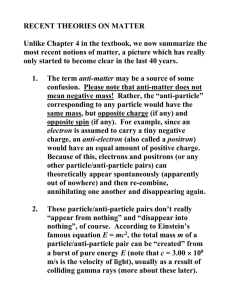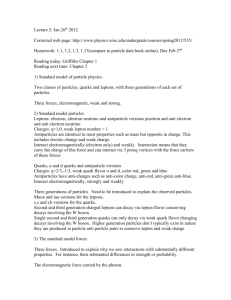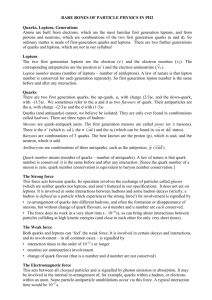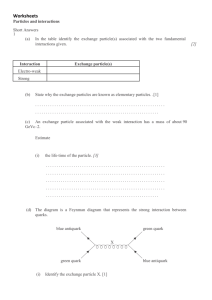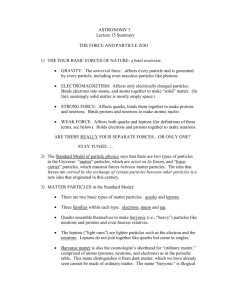The Particle Adventure KEY
advertisement
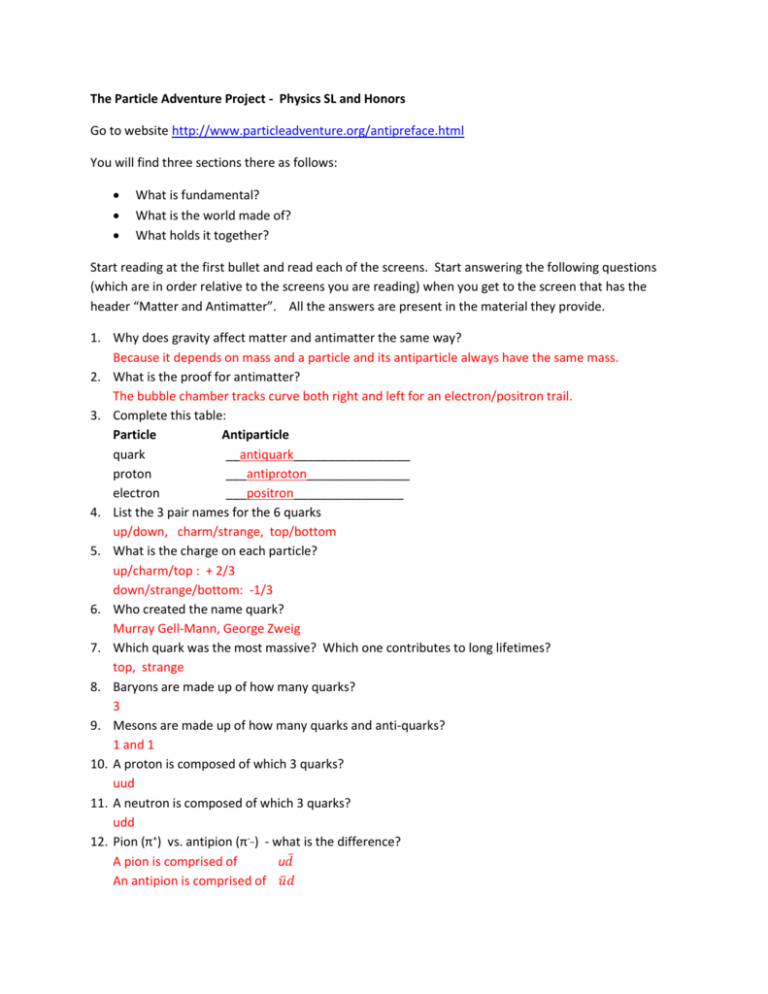
The Particle Adventure Project - Physics SL and Honors Go to website http://www.particleadventure.org/antipreface.html You will find three sections there as follows: What is fundamental? What is the world made of? What holds it together? Start reading at the first bullet and read each of the screens. Start answering the following questions (which are in order relative to the screens you are reading) when you get to the screen that has the header “Matter and Antimatter”. All the answers are present in the material they provide. 1. Why does gravity affect matter and antimatter the same way? Because it depends on mass and a particle and its antiparticle always have the same mass. 2. What is the proof for antimatter? The bubble chamber tracks curve both right and left for an electron/positron trail. 3. Complete this table: Particle Antiparticle quark __antiquark_________________ proton ___antiproton_______________ electron ___positron________________ 4. List the 3 pair names for the 6 quarks up/down, charm/strange, top/bottom 5. What is the charge on each particle? up/charm/top : + 2/3 down/strange/bottom: -1/3 6. Who created the name quark? Murray Gell-Mann, George Zweig 7. Which quark was the most massive? Which one contributes to long lifetimes? top, strange 8. Baryons are made up of how many quarks? 3 9. Mesons are made up of how many quarks and anti-quarks? 1 and 1 10. A proton is composed of which 3 quarks? uud 11. A neutron is composed of which 3 quarks? udd 12. Pion (π+) vs. antipion (π-_) - what is the difference? A pion is comprised of u𝑑̅ An antipion is comprised of 𝑢̅𝑑 You should be at the screen with the header “Leptons” right about now… 13. How many leptons are there and describe them. There are a total of 6: e- electron νe electron neutrino μ muon νμ muon neutrino τ- tau ντ tau neutrino 14. Do leptons exist as composite particles or alone? alone, with neutrinos 15. What is the name for the antielectron? positron 16. What are the leptons that are stable (which 4)? the electron plus three neutrinos 17. If a muon decays, what neutrino does it produce? νμ 18. Give an example of a lepton “family”. muon and νμ 19. What is the rule about lepton decay? The number of members from each family stays constant 20. What is the purpose of lepton type conservation laws? They tell whether a hypothetical lepton decay is feasible. 21. Give one feasible equation for tau particle decay. 𝜏 = 𝜈𝜏 + 𝜇 + 𝜈̅𝜇 𝜏 = 𝜈𝜏 + 𝑒 + 𝜈̅𝑒 22. What is the charge on tau and muon particles? -1 23. Create a table like on the last page for the first decay shown at the top of the page “Quiz-Lepton decay” 𝑦𝑖𝑒𝑙𝑑𝑠 𝜏− → 𝑒− + 𝜈̅𝑒 + 𝜈̅𝜏 Charge -1 = -1 + 0 + 0 τ # 1 = 0 + 0 + 1 e- # 0 = 1 + 1 + 0 24. Create a table like the one on the last question to prove the “no” answer they got for the second question on this “Quiz-Lepton decay page” 𝑦𝑖𝑒𝑙𝑑𝑠 𝜏− → μ# 0 = 𝜇− + 1 + 𝜈̅𝜏 0 Don’t have to go any farther than that, the muon number doesn’t balance. 25. What caused the last decay (3rd question on this page of Quiz-Lepton decay) to not be viable? Energy- the particle cannot end up more massive than it started out. 26. What two types of charge do neutrinos lack? electrical and strong 27. What was the basis for believing that neutrons must exist? conservation of momentum 28. What is the composition of a proton? uud 29. What is the composition of an electron? it is a fundamental particle, composed of only itself 30. How many quarks are required to make a baryon? 3 31. How is a meson different than a baryon? a meson consists of 2 items – a quark and an antiquark a baryon consists of 3 quarks 32. 33. 34. 35. 36. 37. 38. You should now be on a screen titled “The unseen effect” What historical question was answered by considering the exchange of “force carrier particles”? How can 2 objects affect one another without touching? Name one thing that IS affected by a photon and one thing that IS NOT affected by a photon. IS: e- and p+ IS NOT: neutrinos (the are not electrically active) The carrier for the electromagnetic force is (and it’s symbol): photon γ What are the mass and speed of photons? massless and 3.0E8 m/s If two atoms are neutral, how is it that they stick together to form a stable molecule? The charged parts of 1 atom interact with the charged parts of another atom (sound kind of like intermolecular forces in chemistry to you?), an effect called residual electromagnetic force. Why should the nucleus blow apart? Because of the repulsions between adjacent protons in the nucleus. What is the difference between color charge for quarts and color charge for composite particles? Quarks – have color charge, composite particles – have no net color charge 39. What is the relationship between color charge and strong force? The force between color-charged particles is very strong so it’s called the strong force. 40. What is the scale of operation for the strong force? Between quarks and below, not above that size/level 41. 42. 43. 44. 45. 46. 47. 48. 49. 50. 51. 52. Just checking – you should be on the screen titled “Color charge” right now…. Name the 3 color quarks and the 3 color antiquarks red/green/blue antired/antigreen/antiblue (If you are thinking this naming convention is really stupid right about now, I’m with you!) Does color charge have anything to do with visible colors as we know them? Not at all – messes with your mind, doesn’t it? Define gluon (look it up if you have to) An elementary particle that acts as the exchange particle (A.K.A. force carrier particle , or gauge boson) for the strong force between quarks, analogous to a photon for the electromagnetic force. Why are baryons color neutral? They are comprised of the three different colors. Why are meson color neutral? They are comprised of a color and an anticolor pair If you are on the page titled “residual strong force” then you can answer this: So what DOES hold the nucleus together? The strong force between the quarks in one proton and the quarks in another proton is strong enough to overwhelm the electrostatic repulsion. Even though there are 6 quarks and 6 leptons, what does all the stable matter in the universe consist of? up, down, electron, neutrinos Which of the 4 fundamental forces causes heavy quarks and leptons to decay into lighter ones, and creates flavor changes? the weak interaction force When a larger particle decays, the resulting particle always has LESS/MORE mass than the original decayed particle (circle one, then explain). LESS because some of the original particles’ mass is turned into kinetic energy What is a flavor change? When a quark or lepton changes type, like from a muon to an electron. If the strength of the interaction depends strongly on both the mass of the force carrier and the distance of the interaction, then if the photon, the electromagnetic force carrier has no mass, what does that say about the distance that it acts over? as mass goes to zero, the distance goes to infinity - its range is infinite Why has the gravity force carrier not been found? Because the proposed graviton’s interactions are extremely weak and therefore undetectable (or difficult to detect). Check – you should be at “interaction summary” now… 53. What particles does the weak force act on? quarks and leptons 54. How about the electromagnetic force, what particles does it act on? quarks and charged leptons and W+ and W55. What is the strong force carrier? the gluon 56. Which particles have integer multiples of the charge on an electron? Protons, electrons and all others except quarks, which have the +/- 2/3 and +/- 1/3 charge 57. Which particles are NOT color neutral? quarks, gluons 58. What distinguishes quarks and leptons from one another? flavor 59. What is the multiplier for spin that they refer to? Planck’s constant 60. State the Pauli Exclusion Principle No 2 particles in the same quantum state can exist in the same place at the same time 61. Which particles DO and DO NOT obey the Pauli Exclusion Principle? DO – fermions DO NOT – bosons 62. Define what a fermion is and give 3 examples A fermion is a particle with 1/2, 3/2, 5/2 non-integer spins Examples are quarks, leptons, protons, neutrons, baryons (qqq) Atoms with odd mass numbers are fermions 63. Define what a boson is and give 3 examples A boson is a particle with 0, 1, 2 integer spins Examples are all force carriers and all composite particles with an even number of fermion particles, like mesons (𝑞𝑞̅) Atoms with even mass numbers are bosons 64. Have you seen the chart at the bottom of the “Fermions and Bosons” page somewhere? It is on the wall at the back of our room Congratulations – you can now officially say that you have gone off into a quantum reality somewhere!



